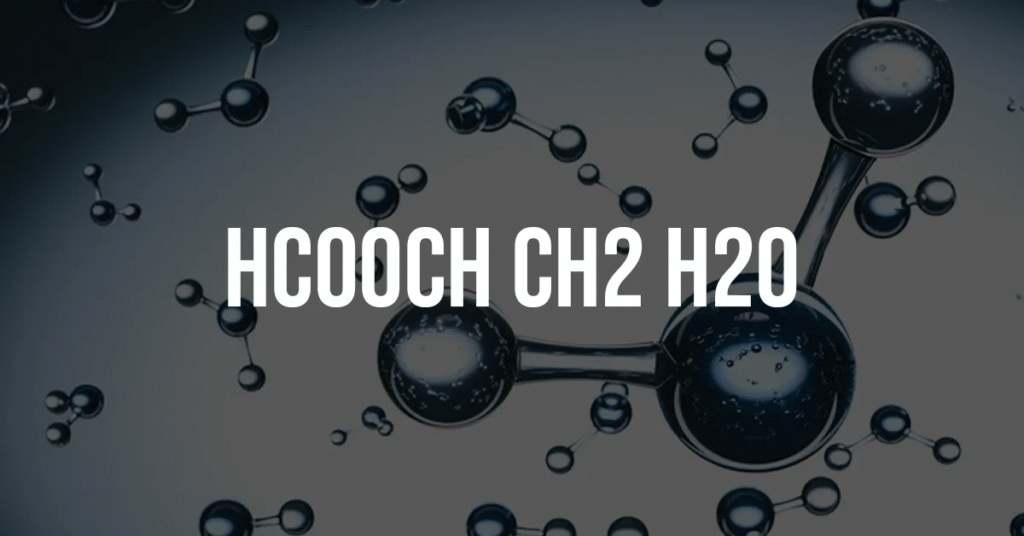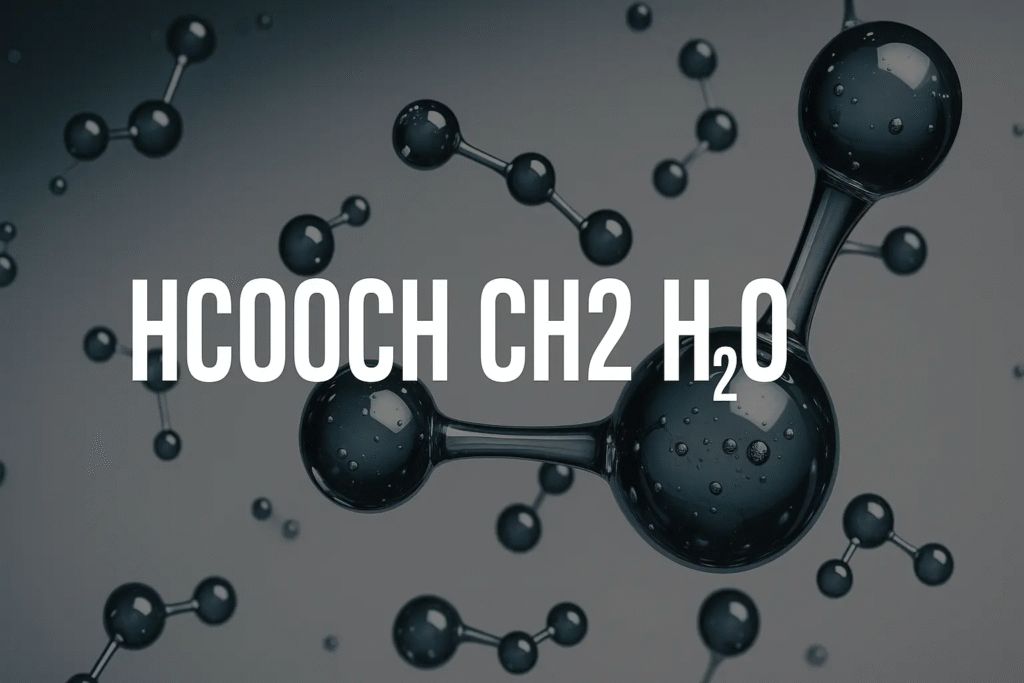The term hcooch ch2 h2o is widely recognized in online chemistry forums and student search queries. Despite being a chemically non-standard term, hcooch ch2 h2o has piqued the curiosity of many who seek to understand what it represents. This article delves into its chemical meaning, origins, properties, applications, economic value, and its surprising place in the universe in detail.
Quick Info
| Feature | Details |
| Common Term | hcooch ch2 h2o |
| Represents | Ethyl Formate (HCOOCH2CH3) and Water (H2O) |
| Chemical Class | Ester |
| Formation Reaction | Fischer Esterification |
| Reactants | Formic Acid (HCOOH) + Ethanol (CH3CH2OH) |
| Key Property | Colorless liquid with a distinct fruity, rum-like scent |
| Boiling Point | 54.3 °C (129.7 °F) |
| Primary Uses | Flavoring agent, industrial solvent, fumigant |
| Economic Sector | Food & Beverage, Chemical Manufacturing |
| Scientific Status | Term is informal; components are well-documented |
Origins and Chemical Background
The term hcooch ch2 h2o does not originate from any formal chemical nomenclature. Instead, it appears to be a user-generated shorthand, likely created by students trying to remember the products of a key organic reaction. As of 2025, it remains a popular search query for those studying introductory chemistry.

Its “origins” lie with two parent molecules: formic acid (HCOOH), the simplest carboxylic acid, and ethanol (CH3CH2OH), a common alcohol. When these two react under specific conditions, they form the products represented by hcooch ch2 h2o. Its background is therefore rooted in the fundamental principles of organic synthesis.
Applications and Industrial Role
hcooch ch2 h2o represents components with a significant professional life in various industries. The primary component, ethyl formate, has a diverse “career.” Its main role is as an artificial flavoring agent in the food and beverage industry, where its pleasant, fruity aroma is used to create the taste of raspberries, rum, and other fruits in candies, baked goods, and drinks.
Beyond flavor, it works as an industrial solvent for substances like nitrocellulose and other resins. It also has a more aggressive role as a fumigant, used to protect stored crops like grains and tobacco from pests. This makes the components of hcooch ch2 h2o highly valuable in both commercial and agricultural sectors.
The Formation Reaction: A Chemical Relationship
The components of hcooch ch2 h2o are formed through a “meeting” of formic acid and ethanol in a process called Fischer esterification. This relationship doesn’t happen spontaneously; it requires a catalyst, usually a strong acid, to initiate the connection.
Their bond is a covalent ester linkage, but this relationship is reversible. Just as the two molecules can come together, the products can also break apart back into the original reactants in the presence of water (a process called hydrolysis). This dynamic, two-way relationship means chemists must carefully control the conditions to ensure the forward reaction is favored.
Products of the Reaction: The Chemical Family
The reaction between formic acid and ethanol produces two “children”: ethyl formate and water. This chemical family has two very different members. Ethyl formate (HCOOCH2CH3) is the “star” product, possessing all the characteristic properties like the fruity scent and industrial utility.
Water (H2O), on the other hand, is the humble yet crucial sibling. While it may seem like a simple byproduct, its presence determines the fate of the reaction. As a product, an excess of water can reverse the formation and break the ester apart. Therefore, managing the water content is essential to the success of the chemical family.
Physical and Chemical Properties
Ethyl formate has a distinct “physical appearance.” It is a colorless, volatile liquid with a low boiling point of 54.3 °C. It is highly flammable. Its most notable feature, its “fashion sense,” is its sharp, pleasant aroma, reminiscent of rum or raspberries.
It is partially soluble in water but is much more soluble in organic solvents like ethanol and ether. This combination of physical and sensory properties dictates its use in various applications, from being a delicate flavor to a powerful industrial solvent.
Economic and Industrial Value
As of 2025, the components represented by hcooch ch2 h2o hold significant economic value. The market for flavor and fragrance compounds is a multi-billion dollar industry, and ethyl formate is a key, cost-effective ingredient. Its production is a staple of industrial chemical manufacturing.
Its value also extends to the agricultural sector, where its use as a fumigant helps prevent the loss of valuable crops. The relatively simple production process and the high demand for the end product ensure that the synthesis of hcooch ch2 h2o components remains a profitable and essential industrial process.
Presence in Scientific Literature and Databases
Unlike a celebrity, the term hcooch ch2 h2o is not active on “social media” or in formal publications. You will not find it in textbooks or peer-reviewed journals. This is because it is an informal, non-standard term.

However, its primary component, ethyl formate, has a massive presence in scientific literature. It is extensively documented in databases like PubChem, Scopus, and the Chemical Abstracts Service (CAS). These official sources contain detailed information on its structure, properties, safety data, and reaction mechanisms, serving as the official record for chemists and researchers.
Perception in Chemistry and Beyond
The perception of hcooch ch2 h2o differs greatly depending on the audience. Within academic and professional chemistry, the term itself is dismissed as incorrect. However, chemists fully recognize the importance of the reaction and the products it represents.
Beyond chemistry, the term gained surprising media attention when astronomers announced the discovery of ethyl formate in space. This finding captured the public imagination—the molecule that makes raspberries smell sweet exists in giant clouds near the center of our galaxy. This shifted its perception from a simple chemical to a molecule of astrobiological interest.
Interesting Facts About hcooch ch2 h2o
- Its primary component, ethyl formate, is responsible for the natural flavor of raspberries.
- It was discovered in a giant dust cloud named Sagittarius B2 in the Milky Way.
- The reaction to form it is completely reversible.
- It is used as a fumigant to kill pests on dried fruits and grains.
- The term hcooch ch2 h2o is a scientifically incorrect but popular shorthand.
- It is used to create artificial rum flavoring.
Conclusion
hcooch ch2 h2o remains an intriguing keyword that bridges the gap between informal curiosity and fundamental chemistry. While the term itself is a misnomer, it represents a crucial chemical system: the formation of ethyl formate and water. Its components are essential to the flavor industry, valuable in industrial manufacturing, and even hold clues to the chemical origins of the universe.
From its signature fruity scent to its presence among the stars, the story of hcooch ch2 h2o demonstrates that even a simple chemical reaction can have a far-reaching impact on our lives.
FAQs
What does hcooch ch2 h2o stand for?
It is an informal shorthand for the products of a chemical reaction: ethyl formate (HCOOCH2CH3) and water (H2O).
What is hcooch ch2 h2o used for?
Its main component, ethyl formate, is used as a flavoring agent for food, an industrial solvent for resins, and a fumigant for crops.
How is hcooch ch2 h2o made?
Its components are made through a reaction called Fischer esterification, where formic acid and ethanol are heated together with an acid catalyst.
Is hcooch ch2 h2o dangerous?
Ethyl formate is a highly flammable liquid. While used safely in food in very small amounts, in its concentrated form, it can cause irritation to the skin, eyes, and respiratory system. Proper safety precautions are necessary when handling it.
Why does it smell like rum or raspberries?
The specific molecular structure of ethyl formate interacts with olfactory receptors in our noses in a way that our brain perceives as a distinct, sweet, and fruity scent, very similar to that of natural raspberries and rum.
Also Read: Mid-Air Crisis Over Europe: The Full Story of the United Airlines Flight UA770 Emergency Diversion


1 Comment
Pingback: Who Was Diane Lou Oswald? Exploring the Life of Woody Harrelson's Mom - News Well